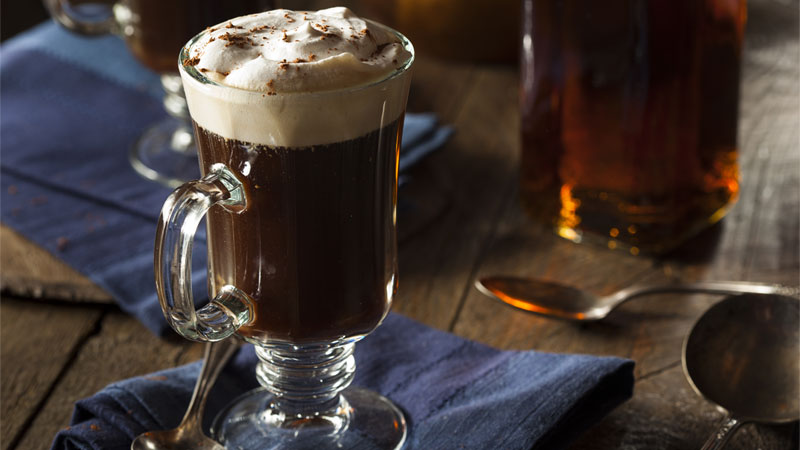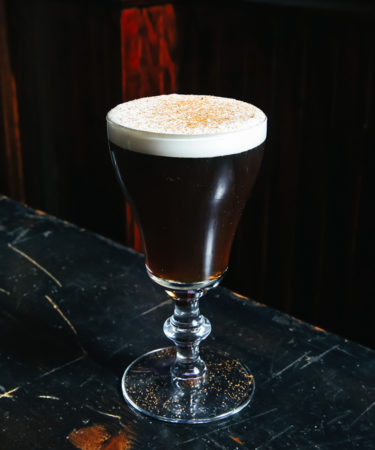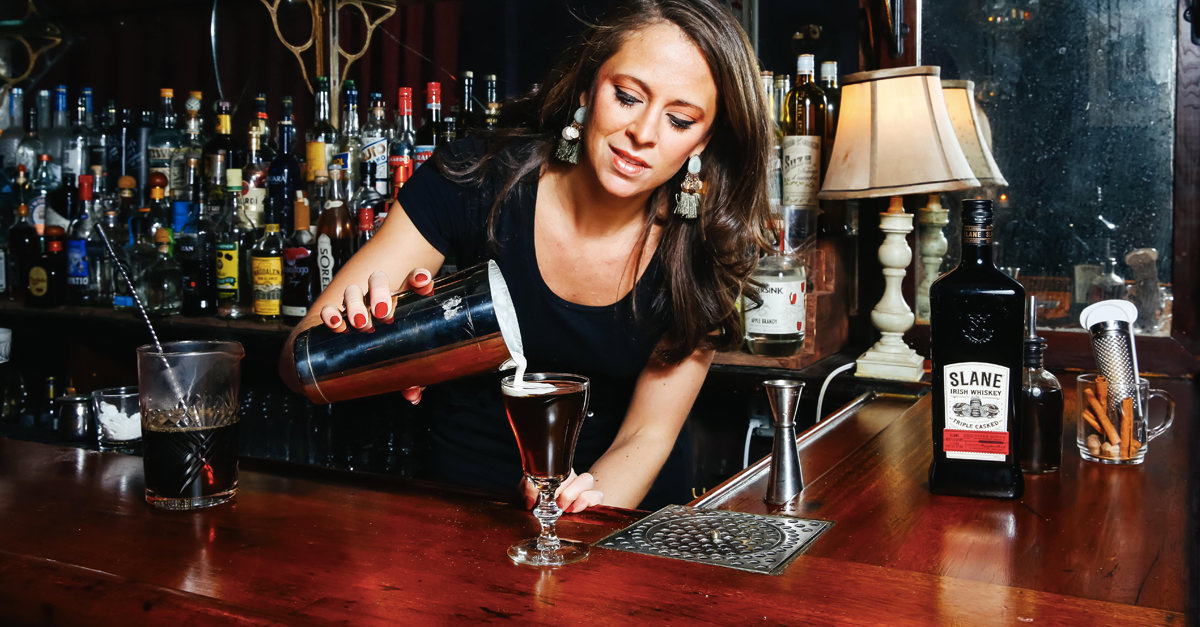“Don’t overthink the coffee,” Pam Wiznitzer says, floating a layer of hand-whipped cream atop two steaming cocktails in Georgian glassware. “People think they should use espresso. You want regular, drip coffee.”
When cocktail legend Dale DeGroff was developing the Irish coffee at The Dead Rabbit, he swapped white sugar for brown in his simple syrup for similar reasons. “I added the brown sugar because I wanted the depth,” he told VinePair in 2016.
Seamstress Irish Coffee FAQ
How do you make an Irish Coffee?
To make an Irish Coffee, start by adding Irish Whiskey. We recommend adding Slane Irish Whiskey, Demerara simple syrup, and coffee to a heatproof Georgian glass, and leaving room at the top of the glass for a cream float. Stir the contents gently, and then add the cream float.
To make the cream float, combine heavy cream and powdered sugar to a shaker and shake for 20 to 30 seconds.
What’s in Irish Coffee?
The ingredients of an Irish Coffee are Irish Whiskey, Demerara simple syrup, hot coffee, and a cream float.
The Irish Coffee Is a Classic Cocktail. Treat It Like One
It’s easy to discount the Irish Coffee as a simple cup of joe spiked with whiskey and garnished with a dollop of whipped cream. In fact, when you order the drink in most restaurants and bars, this is what you shall receive, with varying levels of quality.
But the Irish Coffee is a classic cocktail, and its preparation deserves the same close attention as other concoctions like the Negroni, Daiquiri, or Martini. Perfecting the drink, which comprises just four simple components (Irish whiskey, coffee, sugar, and cream), requires high-quality ingredients mixed in well-balanced proportions.
Whether you’re mixing a batch for friends, or indulging in some smooth, sessionable self-care, here are five timeless tips for perfecting the Irish Coffee.
How to Make an Irish Coffee
Use drip or filter coffee.
Espressos might be the perfect morning pick-me-up, but to create a balanced Irish Coffee, look no further than good ol’ drip coffee.
Jillian Vose, beverage director at The Dead Rabbit in New York, says that using drip coffee, or a French press in a pinch, avoids overpowering the cocktail with the dominant, “condensed” flavor profile of a fresh espresso. (The Dead Rabbit sells roughly 1,000 of its legendary Irish Coffees every week.) Vose recommends a medium-to-dark roast that’s “on the fruity side, but not super bitter,” and advises always brewing a fresh pot just before mixing and serving the drink.
Include a well-balanced whiskey. (Irish, naturally.)
Given that the Irish coffee is the only well-known classic cocktail containing Irish whiskey, there’s no substitute for bottles from the Emerald Isle.
“The best style is a blended whiskey,” Vose explains. “We like something that has a nice grain-to-malt ratio; something that will stand up in the drink and not get lost among the other strong flavors.”
When VinePair carried out our in-house tasting of the best whiskeys for Irish Coffees, we came to a similar conclusion. Our two favorites, Tullamore D.E.W. and Roe & Co., are both blended Irish whiskeys, as were a total of five out of the seven bottles that made the list.
Sweeten with Demerara sugar syrup.
To balance out coffee’s bitter notes, this cocktail requires a dose of sweetness. While sugar (or sweetener) are fine for your morning brew, the best Irish Coffees gain sweetness via a bartender-inspired upgrade.
“The best sugar to use is brown (Demerara) sugar and the best and most consistent way to add it to your Irish Coffee is to make a rich simple syrup,” says Fergus O’Leary, head of beverage operations at The Mayson Hotel in Dublin.
A Demerara simple syrup might sound fancy, but creating one at home is remarkably simple: Combine two parts brown sugar and one part water in a pot, bring to a boil, stirring constantly. When all the sugar has dissolved, turn off the heat.
For a perfectly balanced Irish Coffee, Vose suggests an approximate ratio of six to one: coffee to syrup. Ultimately, though, it depends on the whiskey being used: If the whiskey has a sweeter profile, dial back the amount of syrup and be guided by your palate, she says.

What to Avoid When Making an Irish Coffee
Don’t over-whip the cream.
It’s impossible to know if an Irish Coffee is good without tasting it; but it is easy to spot one that’s been poorly prepared.
When made properly, an Irish Coffee should resemble the nation’s other iconic drink: Guinness. There should be a clearly defined separation between the black mix of coffee, whiskey, and sugar, and the creamy white float on top.
To achieve this, the cream needs to be half-whipped, and added just before serving. “The best thing to use is a protein shaker with a stainless-steel shaker ball inside,” O’Leary says. “You need to half-whip the cream so it can be poured from the shaker. This should take about 20 to 30 seconds of hard shaking.”
As a visual cue, the cream will be ready when the bubbles from shaking start to disappear. If the liquid reaches the stiff consistency of a meringue and can no longer be poured, you’ve gone too far.
Vose also recommends using a protein shaker, but says a mixing bowl and whisk also work fine. She recommends using heavy cream, with a milk fat content between 36 and 38 percent.
While it looks pretty, the purpose of the cream float is not just decorative. “The beautiful thing about an Irish Coffee done well is that you get this great sensation of hot and cool,” says Dave Castagnetti, operator of historic Irish pub Tom Bergin’s in Los Angeles. “The cream sits on top, so you get a cool creamy sensation, and the warmth of coffee which comes right after.”
Besides properly whipped cream, a common technique for avoiding sinkage is pouring over the back of a spoon. This shouldn’t be necessary if the cream is whipped to the correct consistency, though, and all that’s instead required is some patience and a steady hand.
“Don’t rush it,” Castagnetti says.
Serve in correct glassware.
Perhaps the biggest crime against proper Irish Coffees is serving in too large a vessel, Vose says. “This is a sessionable drink — perfect for enjoying during the day — and requires just one ounce of whiskey,” she explains. Using anything larger than the traditional six-ounce Irish Coffee mug and you’ll risk adding too much coffee.
When the time comes to serve, don’t forget to preheat the glass using warm water — just as you’d chill a coupe glass before serving a Martini. “You want the drink to be warm, like you're experiencing a cup of coffee,” Castagnetti says.


